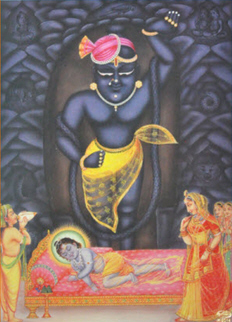
Mangala-arati begins at 5 am. Darshan continues after the arati. During darshan the mukhiyajis, as the priests here are called, close and open the curtain in front of the Deity several times. There is a story that Sri Nathji once tore his garment while rushing back to the temple to be on time for darshan. From that day on, it has been a custom to blow the conch and then wait several minutes before opening the altar doors. The temple of Sri Nathji is said to be the second richest temple in India, the first being the Balaji temple in Tirupati. The Lord wears a large diamond beneath his lips, which is said to have been a gift from the Muslim emperor, Akbar.
Architecturally, the temple is simple, but the devotees’ enthusiasm is one among the greatest in India. Every day Sri Gopal is offered large quantities of opulent foodstuffs cooked in ghee. The maha-prasada is excellent and can be easily purchased at stalls outside the temple.
When the arati starts, the temple doors open, and everyone just piles in. They may be sophisticated businessmen or whatever, but when it comes time to see the Lord it’s “get in somehow or other”. The hall for darshana (seeing the Deity) has a series of broad step-like platforms gradually going higher toward the back, as in a sports stadium. The entrance is on one side and the exit on the other. Women enter toward the front, men toward the back.
It’s pretty rough and tumble. The temple staff at the doors and by the altar in front constantly move people on, saying, “ChaloJé!” (“Please keep moving”). The sevakas, or assistants, by the altar hang onto ropes with one hand to keep their balance and lean into the crowd, waving cloth gamchäs in the other hand to whisk people on. Everyone is moving, saying their prayers, and at the same time being pushed and shoved. But for a few seconds before you get moved on you get a very nice, close darshana of Srinathji.
The self-manifested Deity of Srinathji appeared, it is said, from a big rock on Govardhana Hill in Vrindävana. Physically, He appears as a bas-relief, the front of His form emerging from the stone. He is dressed with cloth wrapped about Him in a stylish and pleasing manner. His dress is changed several times throughout the day. The weather here, as in most of Rajasthan, is ferociously hot in the summer, cold in the winter. So in summer He is lightly dressed, and on winter mornings at mangala-ärati He is wrapped up so warmly you can only see His face.
Although the temple now has electric lights, torchbearers inside the temple still keep up the tradition of shedding light on the Lord with torches (thick sticks topped with cloth soaked in burning oil). After the mangala-ärati, darshana goes on and on. The mukhiyajés—as the priests here are known—close the curtain in front of the Deity, but everyone cries for more darshana. So the curtain is raised and lowered several times.
Finally the mukhiyajés close the door, but still people clamour for more darshana, and so it is opened again. People call out names of the Lord, “Jaya Känäiyäläla! Jaya Vamsidhari!” Then the door is finally closed, and a curtain made of bamboo is let down in front of it, and that’s the end.
People at once offer obeisances and then take up brooms to sweep the temple and the adjoining courtyards. You can see that the people sweeping are not temple staff. They’re people who have taken up the work in the mood of sevä, devotional service.
The temple priests are all followers of Vallabhacarya, who was born in 1479.His son Sri Vitthalanathji raised the worship of Sri Nathji to a very high standard. The temple is under the management of the main acharya (spiritual leader) of the Vallabha-sampradaya, called the Tilakayata. He is the head of the temple. Once, when Sri Vallabhacarya defeated a large group of impersonalist scholars at Vidyanagar, King Krishnadeva Raya presented him with a gift of many gold coins. Sri Vallabhacarya gave most of these to the local Brahmins and kept only seven. Those seven coins were then made into an ornament for Sri Nathji. The Deity still wears it today.
The temple owns nice Goshala-worth visiting -with over 500 cows. One of the cows is called “Sri Nathji’s cow,” and she comes from a lineage that has served the Deity for generations. The milk from this cow is offered only to Sri Nathji to drink.